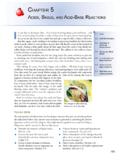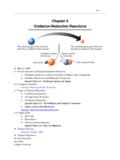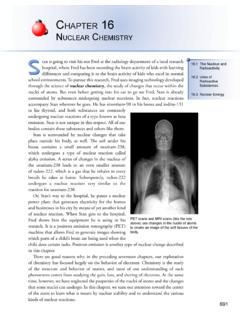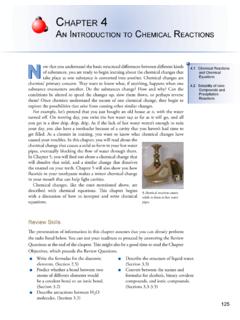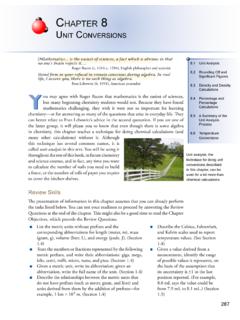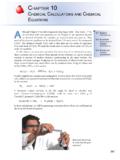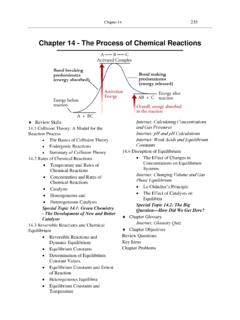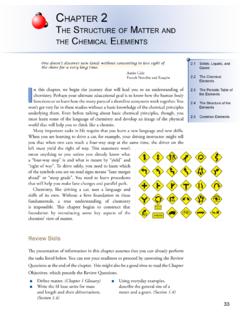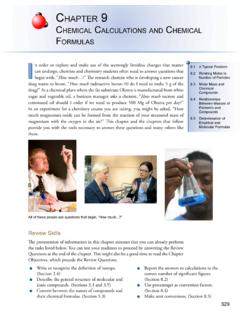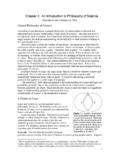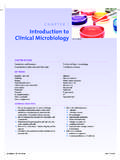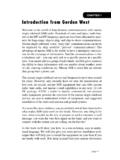Transcription of Chapter 6 - An Introduction to Chemistry: Oxidation ...
1 Chapter 6 Oxidation - reduction An Introduction to Oxidation - reduction Oxidation Types of Chemical Voltaic CellsReview SkillsThe presentation of information in this Chapter assumes that you can already perform the tasks listed below. You can test your readiness to proceed by answering the Review Questions at the end of the Chapter . This might also be a good time to read the Chapter Objectives, which precede the Review Questions. Determine the charge on a monatomic ion in an ionic formula. (Section ) Determine the formulas, including the charges, for common polyatomic ions.
2 (Section ) Identify a chemical formula as representing an element, a binary ionic compound, an ionic compound with one or two polyatomic ions, or a molecular compound. (Section )n many important chemical reactions , electrons are transferred from atom to atom. We are surrounded by these reactions , commonly called Oxidation reduction (or redox) reactions , inside and out. Let s consider a typical new millennium family, sitting around the dining room table after the dishes have been cleared. Mom, a computer programmer, is typing away on her portable computer.
3 She s very anxious to see if the idea she got while on her drive home will fix a glitch in the accounting program at work. Christine, the thirteen year old, is fighting the bad guys on her video game. The electric currents from the batteries that power the computer and the game are generated by Oxidation reduction reactions . Buddy, who s 15, has recently become interested in studying Eastern Philosophy. Just now, he s gazing meditatively out into space, but redox reactions are powering his activity as well; they are important for the storage and release of energy in all our bodies.
4 Dad s an engineer in charge of blasting a tunnel under the bay for the city s new rapid transit project. Each of the explosions that he triggers is created by Oxidation reduction reactions . The silverware he has just cleared from the table is tarnishing due to redox reactions , and the combustion of natural gas in the heater warming the room is a redox reaction as reactions power ourselves and many of our tools and toys. An Introduction to Oxidation - reduction ReactionsObjeCtive 2 ObjeCtive 2 Zinc oxide is a white substance used as a pigment in rubber, sun blocking ointments, and paint.
5 It is added to plastics to make them less likely to be damaged by ultraviolet radiation and is also used as a dietary supplement. It can be made from the reaction of pure zinc and oxygen:2Zn(s) + O2(g) 2 ZnO(s)In a similar reaction that occurs every time you drive your car around the block, nitrogen monoxide is formed from some of the nitrogen and oxygen that are drawn into your car s engine:N2(g) + O2(g) 2NO(g)This nitrogen monoxide in turn produces other substances that lead to acid rain and help create the brown haze above our cities.
6 When an element, such as zinc or nitrogen, combines with oxygen, chemists say it is oxidized (or undergoes Oxidation ). They also use the term Oxidation to describe many similar reactions that do not have oxygen as a reactant. This section explains the meaning of Oxidation and shows why Oxidation is coupled with a corresponding chemical change called , reduction , and the Formation of Binary Ionic CompoundsZinc oxide is an ionic compound made up of zinc cations, Zn2+, and oxide anions, O2 . When uncharged zinc and oxygen atoms react to form zinc oxide, electrons are transferred from the zinc atoms to the oxygen atoms to form these ions.
7 Each zinc atom loses two electrons, and each oxygen atom gains two electrons. Overall reaction: 2Zn(s) + O2(g) 2 ZnO(s)What happens to Zn: Zn Zn2+ + 2e or 2Zn 2Zn2+ + 4e What happens to O: O + 2e O2 or O2 + 4e 2O2 As we saw in Chapter 3, this transfer of electrons from metal atoms to nonmetal atoms is the general process for the formation of any binary ionic compound from its elements. For example, when sodium chloride is formed from the reaction of metallic sodium with gaseous chlorine, each sodium atom loses an electron, and each chlorine atom gains one.
8 Overall reaction: 2Na(s) + Cl2(g) 2 NaCl(s)Na Na+ + e or 2Na 2Na+ + 2e Cl + e Cl or Cl2 + 2e 2Cl The reactions that form sodium chloride and zinc oxide from their elements are so similar that chemists find it useful to describe them using the same terms. Zinc atoms that lose electrons in the reaction with oxygen are said to be oxidized; therefore, when sodium atoms undergo a similar change in their reaction with chlorine, chemists say they too are oxidized, even though no oxygen is present.
9 According to the modern convention, any chemical change in which an element loses electrons is called an Oxidation (Figure ).208 Chapter 6 Oxidation - reduction ReactionsSodiumions Zincions Chlorideions Oxideions 2 2 2+Sodiumatoms Chlorinemolecule Zincatoms Oxygenmolecule Ionic bonds Formation of NaClOxidation of zince 2e 2e Z inc oxideSodium chloridee ++++2+++ An Introduction to Oxidation - reduction reactions 209 ObjeCtive 2 Figure and the Formation of Binary Ionic CompoundsThe concept of reduction has undergone a similar evolution.
10 At high temperature, zinc oxide, ZnO, reacts with carbon, C, to form molten zinc and carbon monoxide gas. ZnO(s) + C(s) Zn(l) + CO(g) Bonds between zinc atoms and oxygen atoms are lost in this reaction, so chemists say the zinc has been reduced. Like the term Oxidation , the term reduction has been expanded to include similar reactions , even when oxygen is not a participant. The zinc ions in zinc oxide have a +2 charge, and the atoms in metallic zinc are uncharged. Thus, in the conversion of zinc oxide to metallic zinc, each zinc ion must gain two electrons.
